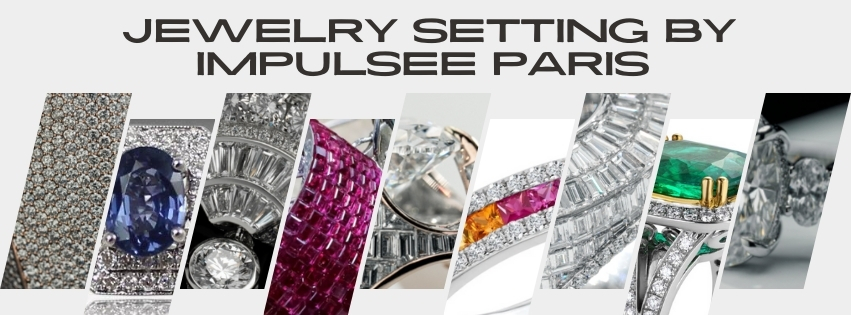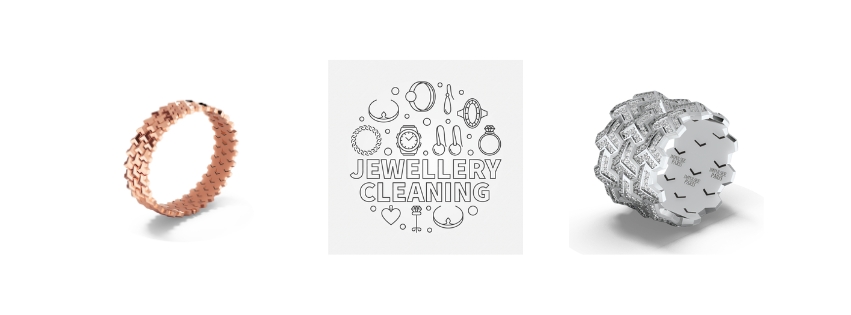Blog
Jewelry Setting: The Art of Enhancing Stones at Impulsee Paris

Jewelry setting is a central and meticulous step in the creation of exceptional jewelry, especially for designs that highlight diamonds. It is through this technique that precious stones, such as diamonds, are fixed onto a piece, revealing their brilliance while ensuring their durability. At Impulsee Paris, we treat jewelry setting as more than just a skill: it is an art. Our house, guided by strong artisanal values, aims to transcend traditional jewelry making to become one of the great references in the field.
In this article, we invite you to explore the fascinating world of jewelry setting, its various techniques, and the rigorous process we follow in our workshop to create unique jewelry, showcasing diamonds and other precious stones.
What is Jewelry Setting?
Jewelry setting refers to the art of securing a precious or semi-precious stone, such as a diamond, onto a piece of jewelry. More than just a technical process, it plays a significant aesthetic role. A well-executed jewelry setting not only secures the stone but also maximizes its brilliance and presence on the jewelry.
At Impulsee Paris, the choice of jewelry setting technique depends on several factors: the type of stone (diamond or other), the design of the jewelry, and the desired effect.
Jewelry Setting Techniques at Impulsee Paris
Our master jewelers are skilled in various types of jewelry setting, each suited to specific creations:
- Claw Setting This classic technique showcases the diamond by minimizing the visible metal. The claws, delicately crafted, hold the stone while allowing light to pass freely, maximizing its brilliance.
- Why this choice? At Impulsee Paris, we favor the claw setting for solitaires and jewelry that requires an intense spotlight on the central diamond.
- Bezel Setting The metal completely surrounds the stone, offering optimal protection and a sleek, modern finish. This setting is ideal for delicate stones like diamonds or for minimalist designs.
- Our expertise: In our workshop, each contour is handcrafted to perfectly embrace the diamond, ensuring flawless results.
- Pavé Setting This method involves setting small precious stones, including diamonds, side by side to create a sparkling surface. The pavé setting is particularly popular for rings, bracelets, and necklaces.
- At Impulsee Paris: We ensure a perfect alignment of diamonds, offering a luxurious and brilliant texture that catches every eye.
- Channel Setting Stones, often diamonds, are inserted between two metal rails, creating a continuous, streamlined line. This setting, elegant and contemporary, is perfect for wedding bands and minimalist creations.
- Our approach: Thanks to unmatched precision, we guarantee perfect stone placement and a refined design.
- Tension Setting The diamond appears to float, held only by the pressure exerted by the metal. This bold and innovative technique requires exceptional expertise.
- Impulsee Paris in action: Our artisans create jewelry where lightness and strength harmoniously combine.
- Invisible Setting Invisible setting is one of the most refined techniques in jewelry, where the precious stone, typically a diamond, is held without any visible prongs. This method is executed with extreme precision, so that the stone appears to float in the center of the piece, fully highlighted without any interference from the metal. The invisible setting maximizes the stone’s brilliance and visual impact while ensuring optimal security.
- Our expertise: Invisible setting requires specialized skill. At Impulsee Paris, our jewelers use high-precision tools to create this delicate setting. The stone is carefully placed into an almost invisible metal cradle, ensuring perfect security without compromising the aesthetics. This technique allows us to create ultra-modern, sleek pieces that captivate with their subtle elegance.
The Jewelry Setting Process at Impulsee Paris
In our workshop, every step of the jewelry setting process is carried out with extreme precision and care to ensure each diamond is perfectly integrated.
- Metal Preparation Our artisans create settings for the stones, whether diamonds or other gemstones, using specialized tools, taking into account their exact dimensions.
- Stone Placement Each diamond is carefully selected and placed to maximize its brilliance and integration into the overall design.
- Fixing Depending on the chosen jewelry setting technique, claws, rails, or metal contours are adjusted to secure each diamond.
- Finishing Once the setting is complete, the piece is polished to reveal its full brilliance. This is when the jewelry comes to life, ready to capture attention.
Jewelry Setting: An Artisan Value at the Heart of Impulsee Paris
At Impulsee Paris, we are not just a jewelry brand. We embody a new impulse in the world of jewelry, driven by strong values: craftsmanship, quality, and innovation.
Every piece that leaves our workshop is the expression of our passion for excellence. Jewelry setting, a key step in our creation process, reflects this ongoing pursuit of perfection. Our artisans put their expertise at the service of your emotions, crafting unique pieces that will stand the test of time.
Our creations are more than just radiant: they are an eternal story. By choosing an Impulsee Paris piece, you are adopting more than just an accessory; you are joining a house where each piece is an invitation to eternity.
Optimize Your Jewelry with Impulsee Paris
We invite you to explore our collections to discover jewelry with various settings, crafted with unparalleled care. To learn more about our story and values, discover our article Discover Impulsee Paris: The Birth of a New Impulse in Jewelry Making.
https://impulseeparis.com/decouvrez-impulsee-paris-la-naissance-dune-nouvelle-impulsion-dans-la-joaillerie/
Impulsee Paris: Reveal your emotions through exceptional jewelry, where every detail is designed to enhance your uniqueness.

